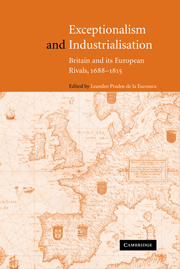Book contents
- Frontmatter
- Contents
- List of tables and figures
- List of contributors
- Acknowledgements
- Introduction: Was British industrialisation exceptional?
- Part I The origins of British primacy
- Part II Agriculture and industrialisation
- Part III Technological change
- Part IV Institutions and growth
- Part V War and Hegemony
- 11 Naval power: what gave the British navy superiority?
- Conclusions
- References
- Index
11 - Naval power: what gave the British navy superiority?
Published online by Cambridge University Press: 04 December 2009
- Frontmatter
- Contents
- List of tables and figures
- List of contributors
- Acknowledgements
- Introduction: Was British industrialisation exceptional?
- Part I The origins of British primacy
- Part II Agriculture and industrialisation
- Part III Technological change
- Part IV Institutions and growth
- Part V War and Hegemony
- 11 Naval power: what gave the British navy superiority?
- Conclusions
- References
- Index
Summary
The common method of comparing the strength of one navy to another is to count the number and size of usable warships, and this is undoubtedly a valid way to begin because sooner or later an inferiority of warship strength had serious consequences. Yet tonnage alone did not signify naval power. This point is illustrated in the second half of the century, when the combined warship tonnage of the navies of France and Spain gradually rose to a figure well above that of the British navy, yet Europeans then feared British naval power more fervently than they had feared it during the first half of the century, when British tonnage exceeded that of any combination of rivals by a wide margin. This came about, it will be seen, in consequence of a fundamental shift in British naval strategy.
The argument that underpins this chapter may be put crudely as follows. Building warships, even very good warships, was rather easy. Consistently repairing and replacing them over the years was harder. Manning them with competent seamen, feeding those men and preserving their health was harder still. And, finally, keeping squadrons operating at sea, especially for extended cruises and on distant deployments, was hardest (and most expensive) of all. The peculiarity of British naval power during the eighteenth century was that it was so steadily employed at sea, actively doing the work of seapower.
- Type
- Chapter
- Information
- Exceptionalism and IndustrialisationBritain and its European Rivals, 1688–1815, pp. 235 - 258Publisher: Cambridge University PressPrint publication year: 2004
- 5
- Cited by

